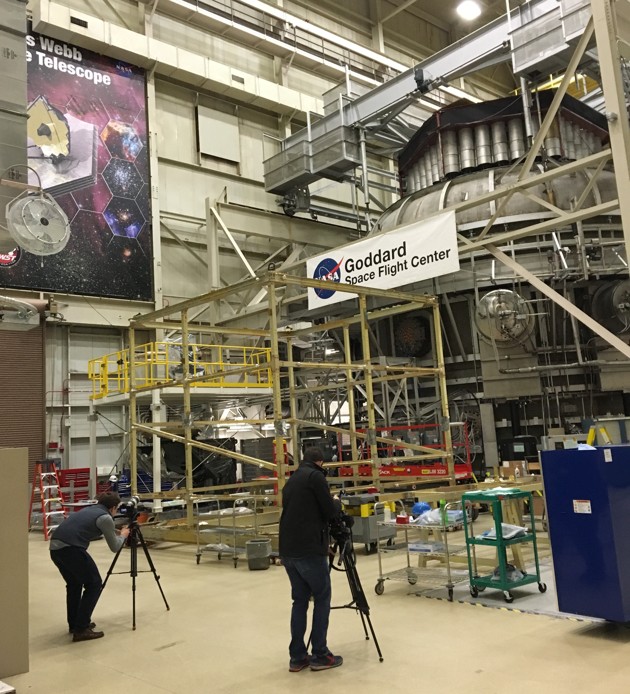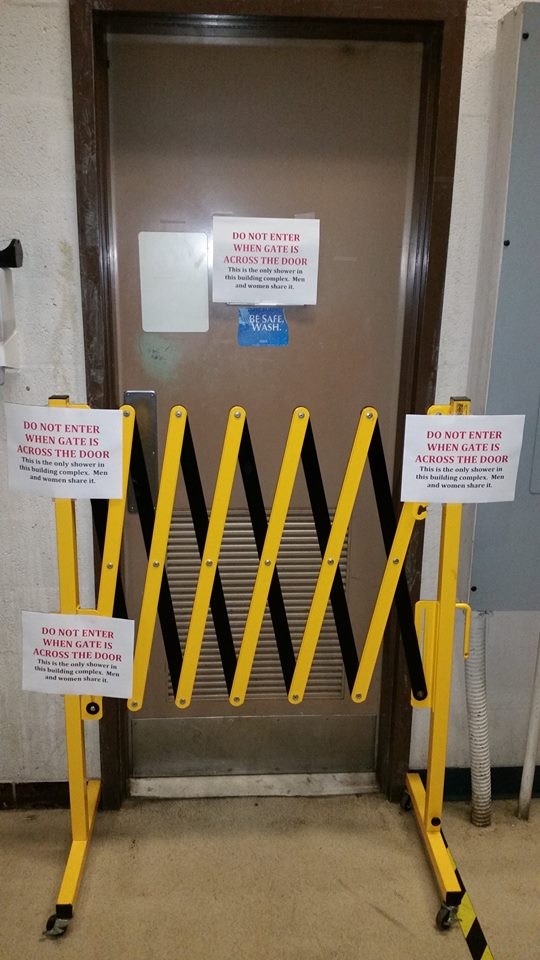Snowed in at NASA, Keeping Watch Over a Space Colossus

Inside NASA's Goddard Space Flight Center's massive clean room in Greenbelt, Maryland, the ninth flight mirror was installed onto the telescope structure with a robotic arm. NASA Goddard Space Flight Center
Time is running out on the agency’s most ambitious science mission in generations, and that means no stopping for anything—not even a historic blizzard.
On Friday, Jan. 22, as the first snowflakes of a historic blizzard began piling atop America’s east coast, a team of more than 20 engineers and scientists hauled food, clothes, cots and mattresses into a building at NASA’s Goddard Spaceflight Center in Greenbelt, Maryland.
The team would remain at the facility until well after the snow let up Sunday morning, keeping watch over a giant, humming “Space Environment Simulator.” The simulator is a cylindrical chamber and, as you might expect from its name, it simulates the conditions of outer space. Its metallic exterior is covered in networks of pipes. Its interior might be the coldest place on Earth. At -233 degrees Celsius (nearly 400 degrees below zero Fahrenheit) it is certainly colder than any of the planet’s natural environments, including the poles.
Sitting inside the Space Environment Simulator are the guts of the most far-seeing camera ever built by humans. This camera will soon be launched into deep space, to image the first stars to flare into being after the Big Bang, and maybe, if we are very lucky, the exhaled gases of life forms that live in the atmospheres of distant planets.
It has been more than 20 years since the first plans were drawn up for what is now called the James Webb Space Telescope. The Webb is the successor to history’s most productive scientific instrument, the Hubble Space Telescope, and it will pack more than 100 times that telescope’s seeing power.
But its long path from back-of-the-napkin idea to tangible, spaceflight-ready hardware has been rocky. The telescope’s design and development phases were plagued by delays, and cost overruns have boosted its price tag to a cool $9 billion. In 2011, several members of the House committee that funds the Webb alleged gross mismanagement, and called for its termination.
NASA was forced to submit a new budget and a new development plan for the Webb, one that culminates in a fast-approaching launch date in 2018.
“It is very important for us to stay on schedule,” NASA engineer Begoña Vila recently told me. “We need to finish on time.”
Even if it means working through a blizzard.
NASA has already put the telescope’s sensors through acoustic testing, to make sure they can withstand the deep, bone-jarring roar of lift-off. The fully-assembled Webb will be 75 feet wide, but when the telescope leaves Earth it will be bundled up and stuffed into the tip of a rocket that will deposit it nearly one million miles away.
Once it reaches its new home, the Webb will attempt an unprecedented feat of reverse origami. Over a period of months, it will unfurl its giant sunshade, its instruments, and its 18 gold-coated mirrors, becoming, in the process, the largest space observatory in the known universe.
The stakes for this metamorphosis are high. Astronauts have flown out to service the Hubble Space Telescope several times since it reached orbit in 1990. But the Webb is being sent to deep space, some three times the distance of the Moon. Even with tomorrow's technology, repair at such a remove from Earth will be extremely difficult. If for any reason the Webb should fail after launch, it will likely be left to idle out of reach, a stillborn in the void.
That’s why testing is so important. Engineers at NASA Goddard have been working around the clock to make sure that the Webb will function in the frigid, airless environment it will soon call home.
Back in October, its instruments were lowered into the center’s Space Environment Simulator. At more than 40 feet tall, the cylindrical simulator is itself an impressive specimen of the technological sublime. After the instruments were sealed in, the simulator’s interior was transformed into an artificial abyss. Vacuum pumps sucked out its air until the interior pressure was only a billionth as strong as Earth’s atmosphere.
When I visited NASA Goddard in early January, I could see ice forming on the pipes that feed into it. Liquid nitrogen and helium had been released into the chamber, to cool it to the -387 degrees Fahrenheit temperature the Webb will experience in deep space. The most powerful of the telescope’s four instruments will need to be cooled even further, to just north of absolute zero, the point where all motion ceases. Only in the grips of that deep chill will it be able to detect faint, long-journeying starlight from galaxies more distant and ancient than any that have ever been glimpsed.

The Space Environment Simulator requires constant monitoring—even through the weekend—to ensure the stability of the chamber, and the priceless instruments it holds. The team typically divides each Saturday and Sunday into three eight-hour shifts. But with a blizzard looming, they worried that the region’s impassable roads would make shift changes impossible.
The team decided to bunk down at Goddard. In the run up to the weekend, they tested the facility’s back-up generators, in case the storm’s high winds knocked out power to the simulator, causing its tiny region of manufactured void to fill up with warm air, exposing the instruments to a violent and potentially ruinous temperature shift.
They did their best to make themselves comfortable.
“We thought we had big offices,” Begoña Vila told me. “But not for full-sized mattresses.” Signs were posted where team members were sleeping, so people would know to be quiet. A small gate was stretched across the building’s single available shower. “We had a sign so people would know whether someone was inside,” Vila said.

I asked Vila about the food situation.
“Some people brought chili beans,” she said. “Not everyone thought that was the best choice for the weekend.”
Whatever sacrifices that particular dining choice may have entailed, they appear to have been worth it. The testing continued without a hitch, and after months of frigid temperatures, the simulator is now beginning its weeks-long warming up period.
Once the guts of the camera are lifted out with a custom crane, and joined to the golden mirrors, the telescope will be shipped to Los Angeles, where its tennis-court-sized sunshade is being built by Northrop Grumman. From there, the whole thing will be assembled and caravanned to NASA’s Johnson Space Center in Houston, which is home to the world’s largest Space Environment Simulator. Houston’s simulator has a mythic past. Its interior was once graced by the spacecraft that carried human beings to the Moon. Next year, the entire James Webb Space Telescope will be lowered into it, for a final major test.
Assuming it passes, the countdown to launch will begin. One can only imagine what NASA’s engineers will be feeling when lift-off is imminent. For many, the Webb is their life’s great work. Never again will they labor so long on a project, especially one that is so consequential. The Webb will let humans see clear back to the beginning of time, and for an encore it may give us reason to believe that we are not alone in this universe. Already, you can feel a buzz building at NASA.
And you can feel something else, too.
In early January, I stood on a catwalk with one of the Webb’s lead engineers, overlooking a hangar-sized testing room. On his face, he wore a distinctive impression, equal parts fear and exhilaration. At one point he turned to me and made himself heard over the steady droning of the simulator.
“We’re all scared shitless,” he said.





